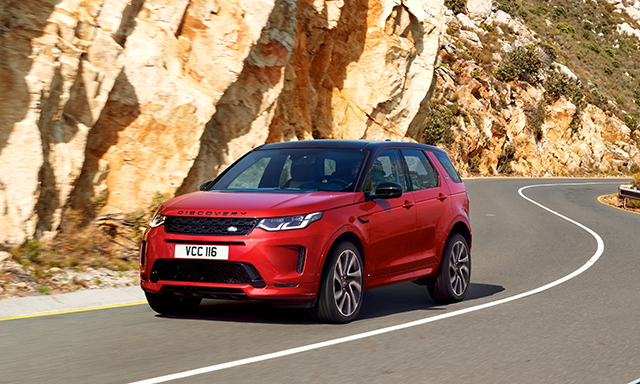You are here
Land Rover Discovery Sport P250: A practical yet premium proposition
By Ghaith Madadha - Mar 13,2023 - Last updated at Mar 14,2023

Photo courtesy of Land Rover
A more affordable and family-oriented Land Rover SUV with compact dimensions and plenty of practicality, the Discovery Sport was at home both on city street school run, as it was on remote snow-packed Icelandic routes, as demonstrated during a first test drive upon its 2015 launch.
A smooth driving, well-mannered and comfortable vehicle with genuine off-road ability, manoeuvrability and cabin versatility ever since, the Discovery Sport was revised in 2019, and gained a subtle aesthetic refresh, along with a more significant driveline and technology update.
Premium practicality
More accessible and practical yet still a premium product in an expanded Land Rover line-up with more choice but narrower differentiation between models, the discretely revised Discovery Sport’s platform is unchanged, but it is 13 per cent stiffer, and features rigidly-mounted subframes for improved refinement, comfort and crash safety. The face-lifted Discovery Sport meanwhile retains its clamshell bonnet and floating roof design with forward-slanted C-pillars. Marginally longer in front owing to revised bumpers, the Discovery Sport, however, adopts a more assertive and bulbous style, and features slimmer and taller front side intakes.
The Indian-owned British manufacturer’s more attainable and utilitarian daily drive SUV, the Discovery Sport nevertheless shares much in both design philosophy and interior ambiance with it nearest, but smaller and pricier in-house Range Rover Evoque counterpoint. With user-friendly layouts, and a classy but uncomplicated upmarket style that incorporates sophisticated equipment and good appointments, the Discovery Sport is a spacious and versatile family car with comfortable and configurable seating, front and rear, and includes high-set stadium style second row seats, and optional third row seats.
In-house engineering
Distinctly more up-market from front and rear views, the face-lifted Discovery Sport’s fascia features a more dramatic style with slimmer, more angular and more dramatic headlights that ditch its predecessor’s ‘crosshair’ design style. More thoroughly updated underneath, the Discovery Sport ditches its former Ford Ecoboost-based 2-litre engine it for an in-house engineered turbocharged 2-litre 4-cylinder Ingenium petrol engine, available in different states of tune, and mated to a slick shifting 9-speed automatic gearbox with a wide ratio range to optimise performance, versatility and economy.
Producing 247BHP at 5,500rpm and 269lb/ft torque over a wide and easily accessible 1,300-4,500rpm range in the more powerful P250 variant, using the Ingenium petrol engine, the Discovery Sport’s combustion engine is aided by a standard 48-volt starter/generator mild hybrid electric vehicle (MHEV) system. Powering ancillary systems, the MHEV system also makes discrete driving contributions on hard acceleration and allows for longer and earlier stop/start functionality, including engine shutdown for coasting on deceleration. The MHEV system meanwhile recoups braking energy to store in underfloor batteries.
Smooth versatility
With its quick-spooling turbo, the Discovery Sport is responsive from launch, but is eager through to redline. Driving all four wheels, it accelerates through 0-100km/h in 7.8-seconds and onto 225km/h, but is best in its rich mid-range torque plateau, where it is confidently versatile accumulating speed on highways. Refined in noise, vibration and harshness isolation, the Discovery Sport is stable, settled reassuring at speed. Though heavier, the revised Discovery Sport nevertheless returns slightly improved 7.8l/100km combined cycle fuel efficiency, in part thanks to its MHEV system.
Comfortable and confident, the Discovery Sport is a manoeuvrable compact SUV with restrained dimensions and tidy interior packaging. Easy to drive and park in the city with its 11.8-metre turning circle, the Dicovery Sport also features a commandingly high and well-adjustable driving position, and good visibility, despite its high-set bonnet. Forgiving over rough imperfections, its suspension is engineered to well-absorb vertical impacts, and is comfortable over all except the most sudden and jarring of potholes and bumps, even with large, firm optional R-Design alloy wheels and tyres.
Utility and manoeuvrability
With quick, direct and light 2.31-turn electric-assisted steering and reassuring grip, the Discovery Sport turns tidily into corners, but its high driving position slightly amplifies the sense of body lean. That said, balanced handling, road-holding levels and active torque vectoring four-wheel-drive make it confident and committed through winding roads and fast bends, and more agile than expected. A practical vehicle, the Discovery Sport also boasts genuine off-road ability, the with good 22.8° approach, 28.2° departure and 20.6° break-over angles, generous 212mm ground clearance and 600mm water fording capability.
To enhance its off-road driving envelope, the Discovery Sport is equipped with Land Rover’s Terrain Response 2 system, which adjusts various driving and system parameters for different conditions and surfaces. Other standard and optional equipment includes a ground view camera for precise manoeuvrability through narrow off-road routes, numerous driver assistance, safety and convenience features, and a mirror display camera with clear unimpeded rear views. A utilitarian and capable vehicle, the Discovery Sport features useful storage spaces, and generous 963-litre luggage volume, which expands to 1,574-litres with rear seats folded.
TECHNICAL SPECIFICATIONS
- Engine: 2-litre, all-aluminium, turbocharged, transverse 4-cylinders
- Bore x stroke: 83 x 92.29mm
- Compression ratio: 10.5:1
- Valve-train: 16-valve, DOHC, continuously variable valve timing, direct injection
- Gearbox: 9-speed automatic, four-wheel-drive
- Power, BHP (PS) [kW]: 247 (250) [184] @5,500rpm
- Specific power: 123.7BHP/litre
- Power -to-weight: 127.4 BHP/ton (kerb)
- Torque, lb/ft (Nm): 269 (365) @1,300-4,500rpm
- Specific torque: 182.8Nm/litre
- Torque-to-weight: 188.2Nm/ton (kerb)
- 0-100km/h: 7.8-seconds
- Top speed: 225km/h
- Fuel consumption, combined: 7.8l/100km
- Track, F/R: 1635/1642mm
- Overhang, F/R: 901/955mm
- Approach/departure/ramp angles: 22.8°/28.2°/20.6°
- Maximum gradient: 45°
- Maximum side slope angle: 35°
- Aerodynamic drag co-efficiency: 0.33
- Boot capacity, min/max: 963/1,574-litres
- Unladen/kerb weight, 5-seat: 1,864/1,939kg
- Suspension, F/R: MacPherson struts/multi-link
- Steering: Variable ratio electric power-assisted rack & pinion
- Turning circle: 11.8-metres
- Brakes, F/R: Ventilated discs, 349mm/discs, 300mm
- Tyres: 235/50R20
Related Articles
First launched in 2015 and revised for the current model year, the Land Rover Discovery Sport’s subtle aesthetic refresh is combined with a
Low, wide, highly stylised and built on a transverse front-drive based platform, the original Evoque proved equally controversial with Land
A highly stylised and modern take on Land Rover’s defining and utilitarian off-roader, the new Defender arrived in 2019 as an altogether dif














